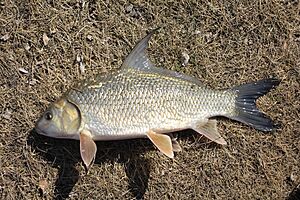Quillback facts for kids
Quick facts for kids Quillback |
|
|---|---|
 |
|
| Conservation status | |
| Scientific classification | |
| Synonyms | |
|
The quillback (Carpiodes cyprinus) is a freshwater fish found all over North America. It's also called the quillback carpsucker. This fish belongs to the sucker family. It looks a bit like a carp because its body is quite deep. But it's not a carp! You can tell the difference because quillbacks don't have whiskers (called barbels) around their mouth. Quillbacks can live a very long time, sometimes over 50 years!
Contents
What Does a Quillback Look Like?
The quillback is a medium-sized fish with a deep body. It has a small head and a humped back. Its tail fin, called a caudal fin, is deeply forked. The quillback's body is flat from side to side.
Its mouth is on the underside of its head and has no whiskers. The fish has large, shiny, silver scales. These scales give the quillback its bright silver color. Its belly is white, and its lower fins are often yellow or orange. The tail and top fin (the dorsal fin) are usually gray or silver.
The quillback gets its name from a special part of its dorsal fin. The first few rays of this fin are very long, looking like a quill. Most quillbacks are about 15 to 20 inches long. They usually weigh between 1 and 4 pounds. However, some can grow up to 26 inches and weigh 10 pounds!
Quillbacks have a very sensitive line along their side. This is called a lateral line. It helps the fish feel movements in the water. This way, they can find food and avoid danger.
Where Do Quillbacks Live and What Do They Eat?
Quillbacks live in many parts of North America. You can find them from Saskatchewan in Canada all the way to Florida in the United States. They also live from South Dakota to Alabama.
These fish prefer clear, slow-moving freshwater. They like places that are moderately deep and have lots of food. You can often find them in rivers, streams, and lakes. Some common spots include the Hudson Bay, the Mississippi River basin, and the Great Lakes.
Quillbacks are bottom feeders, meaning they eat food from the bottom of the water. They usually swim and eat in groups. They are omnivores, which means they eat both plants and animals. Their diet mostly includes small water insects and other tiny creatures. They also sometimes eat snails and water plants.
The Life Cycle of a Quillback
Quillbacks are known for living a long time. They are a slow-growing fish species. Some studies show they can live for more than 40 years! They usually become adults when they are about 8 or 9 years old.
Reproduction
Quillbacks reproduce once a year, usually in late spring or early summer. The exact time depends on how warm the water is. They like water temperatures between 7 and 18 degrees Celsius for spawning.
When it's time to lay eggs, quillbacks swim in schools to special spawning areas. These areas are usually upstream from where they normally live. A female quillback can lay a lot of eggs, from 15,000 to 60,000! She scatters them in shallow water over sand or mud.
The eggs are fertilized outside the female's body. They are then left in calm water to hatch. Since quillbacks are oviparous, their eggs hatch outside the mother's body. Quillbacks have a special mating system where several males and females mate together.
Quillbacks and People
Quillbacks are important for the places they live. As bottom feeders, they help keep the water clean. They eat material from the bottom of rivers and lakes.
Even though they are common, quillbacks are at risk in some places. This includes states like Vermont, New York, and Michigan. They are also vulnerable in parts of Canada like Alberta and Quebec.
It's hard to catch quillbacks with regular fishing methods. This is because of what they eat and how they feed. However, some anglers have caught them using worms, minnows, or artificial lures. The biggest quillback ever caught by an angler weighed over 8 pounds! It was caught in Lake Manitoba, Canada, in 2016.



